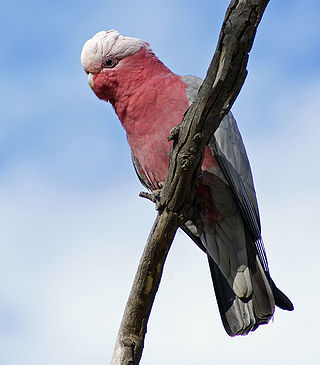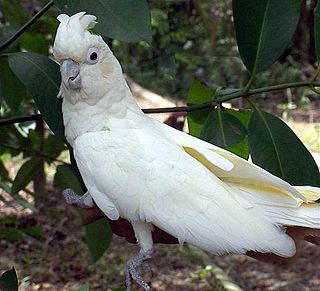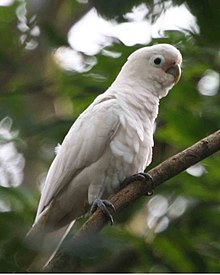
A cockatoo is any of the 21 species of parrots belonging to the family Cacatuidae, the only family in the superfamily Cacatuoidea. Along with the Psittacoidea and the Strigopoidea, they make up the order Psittaciformes. The family has a mainly Australasian distribution, ranging from the Philippines and the eastern Indonesian islands of Wallacea to New Guinea, the Solomon Islands and Australia.

The palm cockatoo, also known as the goliath cockatoo or great black cockatoo, is a large smoky-grey or black parrot of the cockatoo family native to New Guinea, Aru Islands, and Cape York Peninsula. It has a very large black beak and prominent red cheek patches.

The salmon-crested cockatoo, also known as the Moluccan cockatoo, is a cockatoo endemic to the Seram archipelago in eastern Indonesia. At a height of up to 46–52 centimetres (1.51–1.71 ft) and weight of up to 850 grams (1.87 lb), it is among the largest of the white cockatoos. The female is slightly smaller than the male on average. It has white-pink feathers with a definite peachy glow, a slight yellow on the underwing and underside of the tail feathers and a large retractable recumbent crest which it raises when threatened, revealing hitherto concealed bright red-orange plumes to frighten potential attackers. It may also be raised in excitement or in other 'emotional' displays. Some describe the crest as "flamingo-colored". It also has one of the louder calls in the parrot world and in captivity is a capable mimic.

The galah, less commonly known as the pink and grey cockatoo or rose-breasted cockatoo, is an Australian species of cockatoo and the only member of the genus Eolophus. The galah is adapted to a wide variety of modified and unmodified habitats and is one of Australia's most abundant and widespread bird species. The species is endemic to mainland Australia. It was introduced to Tasmania, where it is now widespread, in the mid-19th century and much more recently to New Zealand.

The white cockatoo, also known as the umbrella cockatoo, is a medium-sized all-white cockatoo endemic to tropical rainforest on islands of Indonesia. When surprised, it extends a large and striking head crest, which has a semicircular shape. The wings and tail have a pale yellow or lemon color which is exposed when they fly. It is similar to other species of white cockatoo such as yellow-crested cockatoo, sulphur-crested cockatoo, and salmon-crested cockatoo, all of which have yellow, orange or pink crest feathers instead of white.

The red-vented cockatoo, also known as the Philippine cockatoo and locally katala, abukay, agay or kalangay, is a species of cockatoo. It is endemic to the Philippines. Though pressured by environmental degradation and illegal pet trades, the population of the Philippine cockatoo is somehow growing owing to the Katala Organization. It is roughly the size and shape of the Tanimbar corella, but is easily distinguished by the red feathers around the vent. It is threatened by habitat loss and the cage-bird trade.

The long-billed corella, also known as long-billed cockatoo or slender-billed corella, is a cockatoo native to Australia, which is similar in appearance to the little corella. This species is mostly white, with a reddish-pink face and forehead, and has a long, pale beak, which is used to dig for roots and seeds. It has reddish-pink feathers on the breast and belly.

The sulphur-crested cockatoo is a relatively large white cockatoo found in wooded habitats in Australia, New Guinea, and some of the islands of Indonesia. They can be locally very numerous, leading to them sometimes being considered pests. A highly intelligent bird, they are well known in aviculture, although they can be demanding pets.

The citron-crested cockatoo is a medium-sized cockatoo with an orange crest, dark grey beak, pale orange ear patches, and strong feet and claws. The underside of the larger wing and tail feathers have a pale yellow color. The eyelid color is a very light blue. Both sexes are similar. Females have a copper colored eye where as the male has a very dark black eye.

The Solomons cockatoo, also known as the Ducorps's cockatoo, Solomons corella or broad-crested corella, is a species of cockatoo endemic to the Solomon Islands archipelago. This small white cockatoo is larger than the Tanimbar corella yet smaller than the umbrella cockatoo. The species is common across most of the Solomons, absent only from Makira in the south. It inhabits lowland rainforests, secondary forests, cleared areas and gardens.

The little corella, also known as the short-billed corella, bare-eyed cockatoo, blood-stained cockatoo, and little cockatoo is a white cockatoo native to Australia and southern New Guinea. It was known as Birdirra among the Yindjibarndi people of the central and western Pilbara. They would keep them as pets, or traditionally cook and eat them. The downy feathers are used in traditional ceremonies and dances where they adorn head and armbands.

A companion parrot is a parrot kept as a pet that interacts abundantly with its human counterpart. Generally, most species of parrot can make excellent companions, but must be carefully managed around other common pet species like dogs and cats as they might be hostile towards them.

The red-tailed black cockatoo also known as Banksian- or Banks' black cockatoo, is a large black cockatoo native to Australia. Adult males have a characteristic pair of bright red panels on the tail that gives the species its name. It is more common in the drier parts of the continent. Five subspecies are recognised, differing chiefly in beak size. Although the more northerly subspecies are widespread, the two southern subspecies, the forest red-tailed black cockatoo and the south-eastern red-tailed black cockatoo are under threat.

A parrot harness or bird flight harness is a type of pet harness that is specifically designed to be worn by a parrot.

The blue-eyed cockatoo is a large, mainly white cockatoo about 50 cm (20 in) long with a mobile crest, a black beak, and a light blue rim of featherless skin around each eye that gives this species its name.

The western corella also known as the western long-billed corella, is a species of white cockatoo endemic to south-western Australia.

Tool use by non-humans is a phenomenon in which a non-human animal uses any kind of tool in order to achieve a goal such as acquiring food and water, grooming, combat, defence, communication, recreation or construction. Originally thought to be a skill possessed only by humans, some tool use requires a sophisticated level of cognition. There is considerable discussion about the definition of what constitutes a tool and therefore which behaviours can be considered true examples of tool use. A wide range of animals, including mammals, birds, fish, cephalopods, and insects, are considered to use tools.

Abnormal behavior of birds in captivity has been found to occur among both domesticated and wild birds. Abnormal behavior can be defined in several ways. Statistically, 'abnormal' is when the occurrence, frequency or intensity of a behaviour varies statistically significantly, either more or less, from the normal value. This means that theoretically, almost any behaviour could become 'abnormal' in an individual. Less formally, 'abnormal' includes any activity judged to be outside the normal behaviour pattern for captive birds of that particular class or age. For example, running rather than flying may be a normal behaviour and regularly observed in one species, however, in another species it might be normal but becomes 'abnormal' if it reaches a high frequency, or in another species it is rarely observed and any incidence is considered 'abnormal'. This article does not include 'one-off' behaviours performed by individual birds that might be considered abnormal for that individual, unless these are performed repeatedly by other individuals in the species and are recognised as part of the ethogram of that species.

The grey parrot, also known as the Congo grey parrot, Congo African grey parrot or African grey parrot, is an Old World parrot in the family Psittacidae. The Timneh parrot (Psittacus timneh) once was identified as a subspecies of the grey parrot, but has since been elevated to a full species.
Alice Auersperg is an Austrian cognitive biologist specializing in the evolution of intelligence in birds. Her research is primarily focused on the physical cognition, play behavior, problem-solving and tool-making abilities in parrots and corvids. Since 2011, she has managed the Goffin Lab of Comparative Cognition at the Messerli Research Institute of the University of Veterinary Medicine Vienna in Austria, where she has extensively studied the intelligence of the Tanimbar corella, also known as the Goffin's cockatoo.























